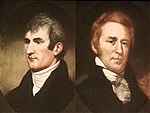Portal:Oregon/Selected article/37
The Lewis and Clark Expedition (1804–1806), was headed by Meriwether Lewis and William Clark. It was the first American overland expedition to the Pacific coast and back. In 1804, the Louisiana Purchase sparked interest in expansion to the west coast. A few weeks after the purchase, President Thomas Jefferson, an advocate of western expansion, had the Congress appropriate $2,500 for an expedition. The American expedition to the Pacific northwest was intended to study the Indian tribes, botany, geology, Western terrain and wildlife in the region, as well as evaluate the potential interference of British and French Canadian hunters and trappers who were already well established in the area. Jefferson selected Captain Meriwether Lewis to lead the expedition, afterwards known as the Corps of Discovery. Lewis selected William Clark as his partner, with 31 others rounding out the group. After beginning the expedition in Spring 1804, they traveled up the Missouri River and built Fort Mandan in present day North Dakota for the first winter. The Corps of Discovery then crossed the Rocky Mountains and journeyed down the Columbia River to the Oregon Coast, arriving at the Pacific Ocean in November 1805. The second winter was spent at Fort Clatsop in present day Oregon where they prepared for the journey home. Leaving Fort Clatsop in April 1806, they reached St. Louis on September 23, 1806, ending the expedition.

